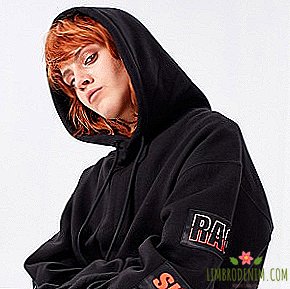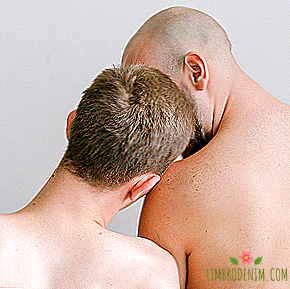Diane Perné about the death of glamor, style icons and creepy 80s
The image of Diana Pernet in the dark wearing glasses and the black veil is familiar even to those who are far from the fashion industry. Schoolchildren in the seventh arrondissement of Paris, where Diana lives, still call her "La Sorcière" (in French - witch). She turned herself into a symbol that is in the same row with the legendary Diana Vreeland, Isabella Blow and Anna Piaggi - these are divas, which today in the world are almost gone.
In the past, an American designer, Diana Perne, moved from New York to Paris, founded in 2005 one of the first fashion blogs - ASVOFF ("A Shaded View on Fashion Film"), and three years later - the short film festival of the same name. It consists mainly of fashion films and takes place in different cities from Antwerp to New York. Pern is also a perfumer: this fall she presented her first line of niche perfume, creating To Be Honest, Desired, In Pursuit of Magic and Wanted perfumes. We talked with her about drug addicts with shotguns and the darkness of New York in the 80s, about how to survive in Paris, and about the disappearance of the dictatorship of fashion.

 How did you get into fashion? What are your first memories?
How did you get into fashion? What are your first memories?
In the 80s I lived in New York and wanted to become a designer, but having decided that I did not draw well, I switched to the movies. I decided to be the director. Many photographed at the time. However, the idea to design did not leave me. I went to a design school, but after nine months I left her and founded my own brand, which I had been studying for thirteen years. In the 80s fashion was awesome. It was a hot disco time, which gave a new impetus to fashion. However, I never loved disco. I was a supporter of minimalism and beautiful strong women. I lived in a nice neighborhood: on the 11th street, the empire of Marc Jacobs was developing next to me, Magnolia Bakery bred, and the inhabitants of Manhattan in the spirit of "Sex and the City" bristled alongside.
 Why then did you leave the city?
Why then did you leave the city?
I could no longer stay in New York - in the late 80s there was a feast there during the plague. The streets were full of homeless people, drug addicts. People died from AIDS. I lived in the East Village area, and ninety percent of my neighbors were then dying or were already dead. The epidemic began, if I am not mistaken, in 1987. A lot of junkies were driven out of Washington Square Park. They all moved to the park right in front of my apartment and turned around at my door. I remember that junkies from this park with a shotgun wandered into our house and cut the telephone wire: I could not even call anyone. They simply came and threatened you: money or death. My neighbor was shot like that. It was a typical situation for that time. It was not worth it to live there and walk along the edge of a knife, and as a designer it did not inspire me at all. It was evil there. I can not even say how bad everything was. So I moved to Paris, which also turned out to be gloomy for me. At least the first three years.
 Why? Paris seems to have no such image.
Why? Paris seems to have no such image.
Paris does not like foreigners. Nobody here offers a job, as they are afraid of you. They are afraid that you may be better than them. If you got a job in Paris a year later and have been holding onto it for three months, it’s better to kill someone who can claim your place. Therefore, the French so protect their territory. Instead of working your name is for parties and dinners. So, me and my friend, like fashion accessories, were invited to all parties in the city. If you can still survive, gain a foothold, then only in three years society will accept you. In New York, I was already a prominent figure, and then I had to start from scratch. I was rather modest, but I knew for sure that I wouldn’t go to work for another designer.

Short or long skirts to wear - you decide. The time of the dictatorship of fashion, like fifty years ago, has passed

 How did you manage to survive this?
How did you manage to survive this?
God knows! I started with a small case. She worked as an assistant producer on the TV show Fashion Files, photographed Première Vision for installations, and made costumes for films, in particular, for the 1992 film "Golem, l'Esprit d'Exile" by Amos Gitay. When I moved, the first three months, which lasted forever, thought that my savings would be enough for a year. I did not know that I would have to stretch these savings for all three years. However, I managed to stay afloat. Sometimes we, accustomed to the New York rhythm, it seemed that nothing happened here. We hung out, took on casual work, and told ourselves that the bird was making the nest gradually, gaining patience. They waited for these three years of trials to pass. But there is a trick: problems in this city are solved through other foreigners. Because they were your skin. They helped me a lot.
 You worked as a fashion editor and made one of the first fashion blogs. How did you come to create the perfume?
You worked as a fashion editor and made one of the first fashion blogs. How did you come to create the perfume?
I dreamed about it twenty years ago when I sewed things in New York. Three years ago, my friend Cristiano Seganfreddo, art director of Unscent, suggested that I take this idea seriously and introduced me to distributors of such niche brands as Diptyque. My work went without deadlines, calmly. It took a year to create the first fragrance. About the same and even more - on the other. I combined one ingredient with another, thought for a long time what to add: black oranges, cedar or patchouli. It was extremely meditative. I myself have been wearing the Comme des Garçons Avignon, the Comme des Garçons Hinoki and the male Guerlain Vetiver for many years. As you can see, this is a perfume outside of gender. The same Comme des Garçons are beautifully revealed on both men and women. Speaking of the spirits created by me: they are different, but everything about me. In woody To Be Honest, for example, there is a note Comme des Garçons Avignon, Desired - berry and oriental, In Pursuit of Magic - lime and stupefy. Soon, by the way, will come another fourth - Wanted. While working on Wanted, I thought about the movie “Night Porter” with Charlotte Rampling in the lead role, but the name for the perfume is taken from the title of the documentary film about Roman Polanski “Wanted and Desired”.
 Even 30-60 years ago, a worthy new film, album, designer's collection could become a big event. Make a revolution. Change generation values. Trends made sense because the past was fundamentally changed. It seems that now we live in the epoch of micro-events, and not macro. What can be a big event today?
Even 30-60 years ago, a worthy new film, album, designer's collection could become a big event. Make a revolution. Change generation values. Trends made sense because the past was fundamentally changed. It seems that now we live in the epoch of micro-events, and not macro. What can be a big event today?
In a fashion this interaction with digital and new technologies. For example, digital display. Here you can recall the recent show Gareth Pugh. I think in the near future, runway shows should disappear or become more impressive. For example, take place in the format of a closed dinner. Or become public: the show will sell tickets, like in a theater or an exhibition. The current shows for the most part are boring and look like a waste of time. From the point of view of design, a thousand ways have been invented, how and what to wrap up arms, legs and the rest of the body. It is important that in addition to design can provide consumer textiles. You put on a sweater - and your heart becomes calm? Antidepressant sweater? I know one designer who is already working on it. Google accessories are the future today. For a designer, the main thing is to choose your niche and act. Sportswear, pajamas or slippers - go ahead! Someone makes minimalism, someone is fond of excessive decoration, but the market and opportunities are equal for all. There is a client for everyone. Short or long skirts to wear - you decide. The time of the dictatorship of fashion, as fifty years ago, has passed.
 When I look at Modern, cool in terms of design collection, I always think, who will it wear? Things look cool on the set, in an advertising campaign, but they are hard to imagine in life. Why is there such a gap with reality? People far from fashion think that half of the styling and modern collections are just ugly.
When I look at Modern, cool in terms of design collection, I always think, who will it wear? Things look cool on the set, in an advertising campaign, but they are hard to imagine in life. Why is there such a gap with reality? People far from fashion think that half of the styling and modern collections are just ugly.
Yes it's true. When I worked as a fashion editor at Joyce, I had to communicate a lot with buyers. In particular, there was one multi-brand from Hong Kong, from which we took things for filming. Then I understood a simple thing: how a journalist and a stylist, a buyer, a merchandiser, a designer and a buyer perceive fashion - different points of view. The journalist and the stylist think about the beautiful picture, the buyer - what they will buy (his goal is to make money), the merchandiser - what will look good in a shop window. Therefore, it is important for a designer to make several impressive stand out items for the press. These things you will see on celebrities and unlikely - in the store. Some designers for one season make two collections: one for the show and the press, the other for the showroom and buyers. For example, so do Stella McCartney or Thom Browne. Gucci is also famous for this.
 It turns out two realities, and that which is shown in magazines is completely divorced from life.
It turns out two realities, and that which is shown in magazines is completely divorced from life.
Magazines are inspiring. Who really sells today is celebrities. Even the most incredible things people accept and want if they ever see them on celebrity. Sells a desire to imitate. So unusual becomes ordinary. As a result, Instagram all reconcile with each other.
 Each designer sculpts his image of a woman. There used to be style icons, but today someone has honored androgynous intellectuals, someone has fun and sexy, someone has sportswomen. Do you notice any single idea that conveys the spirit of the times? and what brands are close to you?
Each designer sculpts his image of a woman. There used to be style icons, but today someone has honored androgynous intellectuals, someone has fun and sexy, someone has sportswomen. Do you notice any single idea that conveys the spirit of the times? and what brands are close to you?
Women are different. For example, girls in men's clothes are always sexy. My favorite brands are Dries Van Noten, KTZ and the little-known Boudicca. Things of these brands make up half of my wardrobe. I can wear something sporty KTZ, and then something classic Dries Van Noten. I love what Haider Ackermann, Rick Owens, and Ray Kawakubo do for the Comme des Garçons. Of all of them, Dries van Notein is out of time for me. His things, indeed, are trendless and valuable. Modern is the designer who, with all the conceptuality, feels the female body.

Pay four thousand euros and look like a fungus on the legs. Are you seriously?

 But progressive brands are absolutely warp this body.
But progressive brands are absolutely warp this body.
They are progressive because their things are saying. Complete sentence What Rae Kawakubo does is brilliant in terms of art. This is a manifesto. I never wore her things. I only have her bag, and her perfume is my favorite. Her new collection instilled a horror in me: things resembled a cancerous tumor, and the models - "Elephant Man". The show was a woman in one of the similar dresses I do not know for how many thousands of euros - I looked at her with horror. Pay four thousand euros and look like a fungus on the legs. Are you seriously? If you are Lady Gaga, then it is ok. But Ray and her husband are smart businessmen. They express themselves as artists and at the same time surround themselves with airbags. Their wallets and perfumes are buying around the world, and they keep the whole business afloat. Another example of a successful timeless designer is Azzedine Alaya. While in the 80s and 90s at the peak was deconstruction, it was about the design and has not changed itself until now. He doesn't even care about the show, he may miss the season at all: he has loyal customers. Speaking of ugliness - Miuccia Prada always loves to play on the edge. The perception of beauty is different for everyone. Ugliness is beautiful too. I love flowers, but maybe you - no, or you like dead flowers. Today there is a place for everything. Should be tolerant. I repeat, the dictates of fashion are no more. We do not live in the 50s, when it was necessary to wear a skirt of a certain length, and jeans were considered a symbol of rebellion.
 You are an icon of style. your image is inspiring. you can just admire. Did you have icons for whom you were oriented and who influenced your taste?
You are an icon of style. your image is inspiring. you can just admire. Did you have icons for whom you were oriented and who influenced your taste?
My icons are from the cinema. In childhood, the Italian actress Anna Magnani was my role model for me. Then - Charlotte Rampling, Jeanne Moreau, Sophia Loren. They have a passion. My cinema aesthetics is Federico Fellini, Pierre Paolo Pasolini, the French New Wave. I was stimulated to do design by the work of American couturier Charles James.

 Now there is little glamor. Do not you miss him?
Now there is little glamor. Do not you miss him?
Today glamor is in danger. I would say glamor is dead. I love glamor, but he stayed only on the carpet and in the hands of star stylists. Maybe, if women did not live in such a hurry today, the glamor would have more chances. Even Uma Thurman lost it. The problem is lack of attention. We spend it on our iPhone and Internet. Glamor doesn't always mean dresses to the floor. Remember: Marlene Dietrich, Greta Garbo, Ava Gardner and Katherine Hepburn are casual and classic at the same time. They had no stylists who told them what to wear. Just think: the glamor was natural. Glamor was inside these women. Glamor is a magnetism, a fantasy. Thanks to the glamor there is haute couture. I think people miss glamor. Therefore, carpets attract so much attention around the world.
 Which modern women can you target?
Which modern women can you target?
On Tilde Swinton. All intellectual brands look perfect on it. But it is not about glamor - it is about artistic expression. Chloe Sevigny and Charlotte Gainsbourg. Modern icons are an idea, power and beauty. Character!
 Why do you wear only black all the time?
Why do you wear only black all the time?
I adore black color. It is purity, elegance and strength. This is the most soothing color. It can be worn from morning till night - and it will be ok. In it, I feel comfortable, and besides, black clothes can be less often dry-cleaned. With white color, I started in the 70s. I wore white Victorian-style bows: white lace, pearls. I love the colors they charge. My apartment is all colored! I do not live in a black house, as everyone thinks. If I get black flowers, I will cry.
Photo: ASVOFF




